When you mention to friends back home that you are going on a research cruise, most people think of Jacques Cousteau or The Life Aquatic, or perhaps relaxing on deck in the tropical sun, being served cocktails by stewards. If only!
A typical day on the AMT4SentinelFRM field campaign starts at 03:30 a.m. when the zooplankton team (Erica Goetze from the University of Hawaii, Katjia Peijnenburg, Deborah Wall-Palmer & Lissette Mekkes from the Naturalis Biodiversity Centre, The Netherlands) deploy their bongo nets with the help of Richie Phipp (NMF-NOC, UK) to fish for zooplankton, gastropods, pteropods and copepods; the tiny animals that comprise the fish food in the ocean.
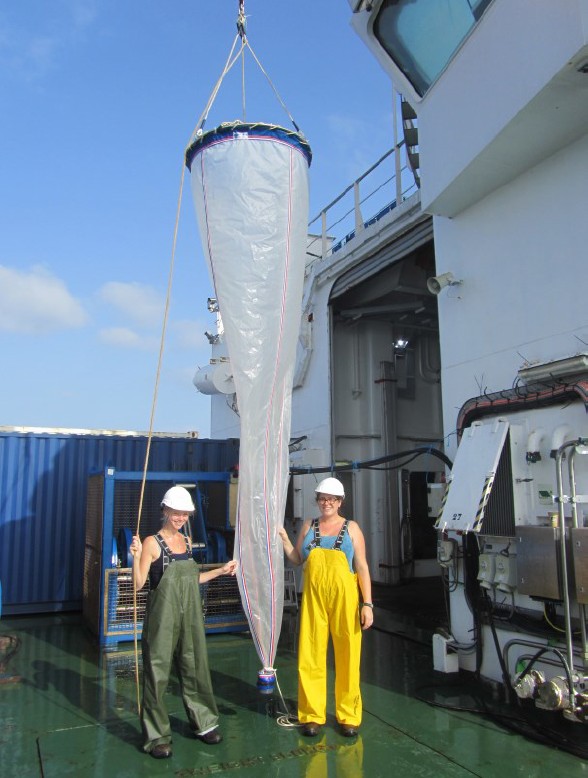
Bongo net deployment
The transect of Zooplankton net hauls in the Atlantic tells us about the distribution of these animals, potential genetic barriers to their diversity and, over time, enables us to monitor changes in these communities as a result of sea-surface warming. In addition, Deborah and Lissette are studying the effect of elevated CO2 and decreasing pH under future climate change scenarios on some calcareous species that inhabit the Atlantic Gyres and which form an integral link to the higher mammals and fish that prey on them.
At 4:30 a.m. Glen Tarran from PML and Hashan Kokuhennadige (POGO fellow from Ruhuna University, Sri Lanka) also deploy a vertical haul net which has a series of net sizes from 200 micrometers which catches plankton. As the net trawls are hauled aboard, and the zooplankton team retreat to the constant temperature laboratory to identify and characterise the day’s catch, a throng of technicians and other scientists emerge for the pre-dawn CTD.
The CTD is a stainless steel cage that houses temperature, conductivity (salinity), oxygen and fluorescence probes (phytoplankton biomass). CTD stands for Conductivity, Temperature and Density device. At the bottom of the cage there is a transmissometer which measures the transmission of light through the ocean, a pair of Acoustic Doppler Current Profiler (ADCPs) that measure ocean currents and boundaries in the water column, and Francesco and Gavin’s optical backscatter meters that measure scattered light emitted from particles in the water column. Around the perimeter of the cage there are 24 ‘bottles’ that hold 20 litres of seawater each. The bottles are cylindrical, PVC tubes with rubber sprung caps that close over the top and bottom end of the tubes.
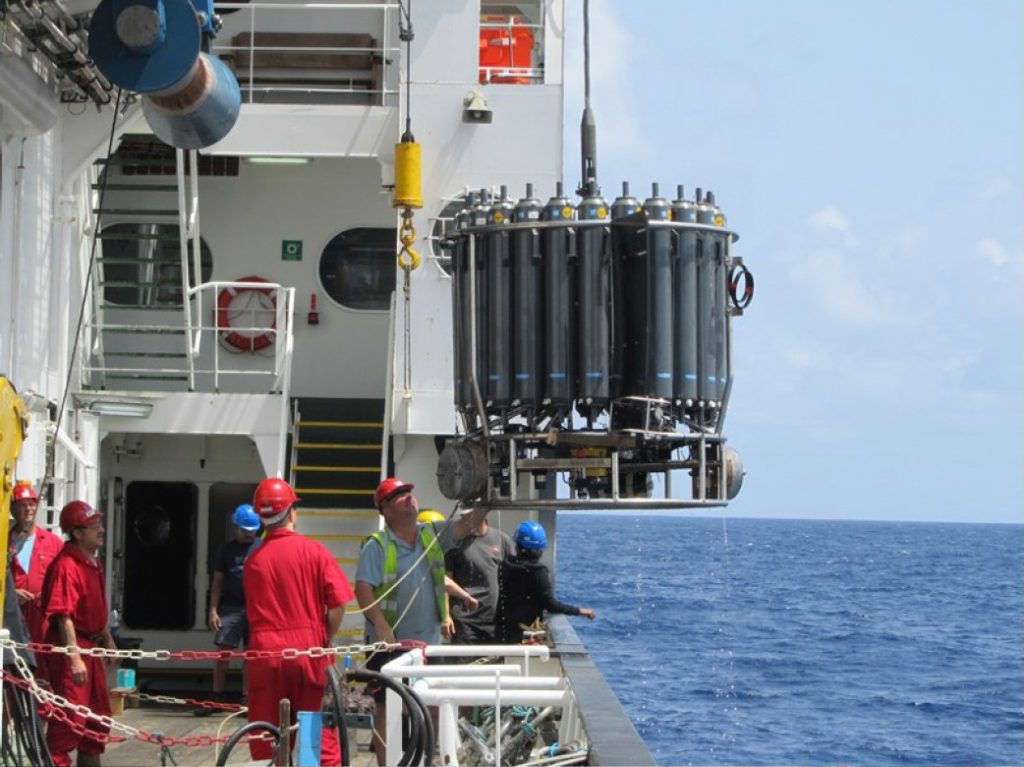
The Conductivity, Temperature and Density (CTD) device
The CTD is operated by Dave Childs and Colin Hutton (National Marine Facilities, NOC, UK) and is lowered into the water from a winch operated by the ship’s crew. As it descends, the profiles of salinity, temperature, fluorescence, light penetration and oxygen are plotted on a computer screen in the control room. From these plots, we decide where to collect water and as the CTD is winched back up through the water column, it is settled at a desired depth, and bottles are ‘fired’ or closed using computer software interface to capture the water from that specific depth.
On this research campaign, we generally deploy the CTD twice a day to a depth of 500 meters just below the sunlit zone. The procedure takes approximately one hour. Once recovered on board at approximately 05:30, gases dissolved in seawater are tapped off first; Rebecca May (PML Lloyds Register Foundation Apprentice) and Cristabel Fernandes (POGO fellow from National Institute of Oceanography, Goa, India) measure the oxygen and nitrousoxide content of the water, respectively.
Then samples are taken for the following measurements: macro-molar nutrient concentrations by Carolyn Harris (PML, UK); quantification of nitrogen fixation by Hashan Kokuhennadige; characterisation of the dissolved organic material by Arwen Bargery (British Oceanographic Data Centre, UK); enumeration of bacteria and small phytoplankton by Glen Tarran (PML, UK); estimation of primary production by Denise Cummings (PML, UK); uptake of nutrients by the small phytoplankton by Mike Zubkov’s (NOC, UK) group: Nina Kammenaya (University of Warwick, UK), Alicja Dabrowska (University of Warwick, UK); Zooplankton DNA by Erica Goetze (University of Hawaii); Oxygen Stable Isotopes by Katjia Peijnenburg (Naturalis Biodiversity Centre, Leiden, The Netherlands).
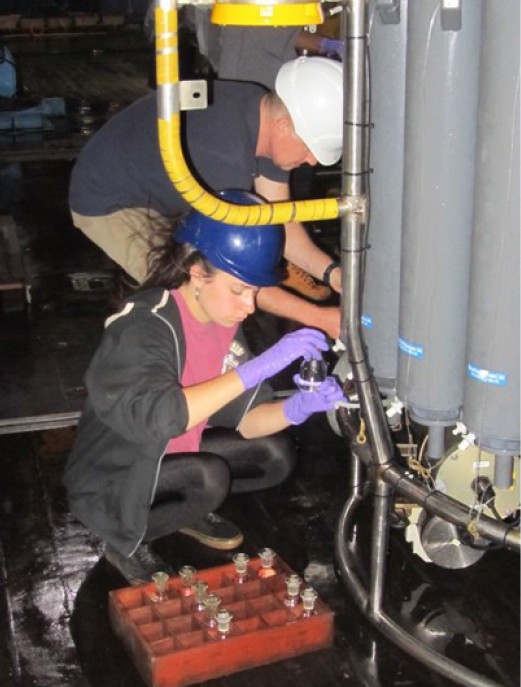
Taking samples from the CTD
All of the water column processes from nutrient concentrations to carbon and nitrogen fixation by phytoplankton up to the zooplankton are measured, as an international collaborative team effort, to provide a snapshot at each station of the water column processes and biological communities behind them. These measurements keep everyone busy throughout the morning, which is punctuated by breakfast served from 07:20.
After breakfast, the optics team (Gavin Tilstone and Francesco Nencioli, PML) initiate the array of optical radiometers located on the met platform on the bow of the ship. These instruments measure reflectance of light from the sea and are used to validate the same products measured by the Copernicus Sentinel satellites that orbit over the ship daily.
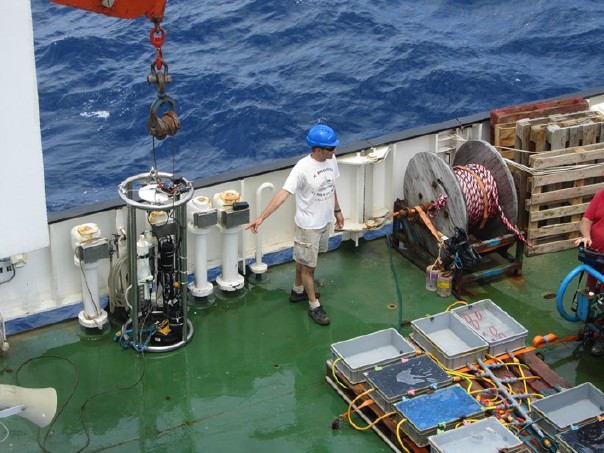
Preparing the launch of the optical profiler
In tandem with these measurements, Francesco also runs the PML underway optical system that continuously measures the absorption and backscattering properties of the surface phytoplankton communities. These measurements are used to develop new algorithms for Ocean Colour satellites to improve quantification of the phytoplankton and detrital biomass and quantification of dissolved organic carbon. Every four hours throughout the day, a series of water samples are drawn off the ships surface seawater supply for the measurement and characterisation of, salinity (Andy Moore, NMF-NOC, UK), nutrients (Carolyn Harris, PML, UK) and phytoplankton pigments (Gavin Tilstone, PML, UK).
The next station is the midday CTD cast, optics rig and zooplankton net deployments. Prior to this, Francesco and Gavin climb up to the met platform to clean the lenses on the optical radiometers.
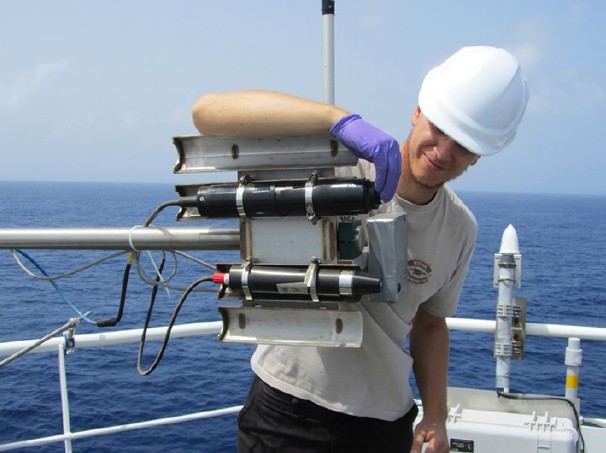
Cleaning the lenses on the optical radiometers
The optics profiling rig is also cleaned. There is then time from 11:20 to grab a quick lunch before arriving on station. The ship is manoeuvred with the sun at a 90 degree angle to the bow to provide the optimum measurement angle for the radiometers and to ensure that there is no sun glint which will saturate the sensors.
Once on station, Werenfrid Wimmer (University of Southampton, UK) launches a meteorological weather balloon to measure the atmospheric temperature, humidity, pressure, wind speed and direction. These measurements are used to model and correct for atmospheric effects in the satellite data.
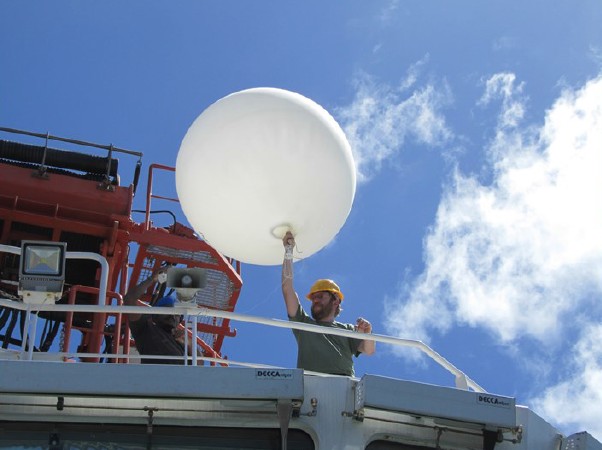
Launching a meteorological weather balloon
The optics rig is then swung away from the ship using the afterdeck crane and deployed to 250 metres by Richie using the deck winch. The optics rig houses a number of instruments including: a WETLabs ac-S which measures absorption (a) and attenuation (c) of the particles in the water column; a WETLabs backscatter meter which measures the backscattering of particles; a SATLANTIC UV sensor which measures the amount of ultra-violet (UV) light penetrating through the water column and a CTD that measures temperature, salinity and fluorescence. These data are used to characterise the fate of sunlight as it penetrates the ocean.
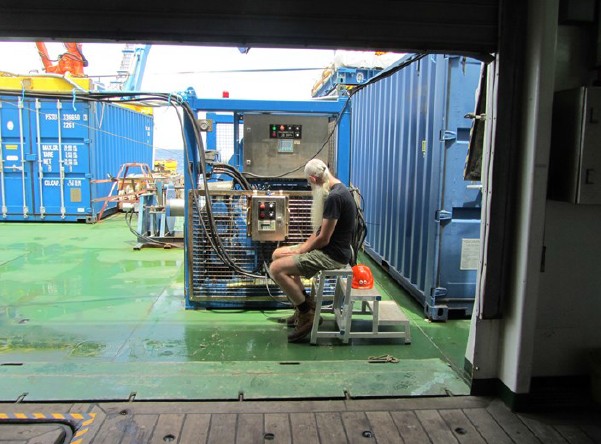
Operating the winch for deployment of optical profiler
Coincident with this, the CTD is again deployed to 500 metres and sampled for the parameters listed previously from phytoplankton carbon fixation to genetic diversity. Every fourth day, the CTD is deployed to 1000 metres alongside SAPS (Stand Alone Pumps) for Phyllis Lam and Andy Rees’ team (Jessica Fuessel, NOC, UK & Ian Brown, PML, UK) to characterise nitrogen cycling by bacteria in locations of oxygen minima and maxima in the water column.
Measurement of the samples taken from the midday CTD lasts throughout the afternoon until dinner which is served at 17:30. The ship travels approximately 65 nautical miles between each pre-dawn and midday CTD casts and 120 miles between midday and the following pre-dawn cast. Dave and Colin normally deploy around 100 CTD’s on this research campaign. At specific locations along the cruise track, Francesco Nencioli and Werenfrid Wimmer deploy bio-argo floats, argo floats and drifters from the UK Met Office and the University of Washington that will follow the ocean currents profiling from the surface to 500 meters and collecting information on the physics, chemistry and biology of the Atlantic Ocean for the next five years.
After dinner the scientific team work up the day’s data. At sunset the radiometers are switched off and the incubations for carbon fixation to estimate primary production of different phytoplankton size classes are terminated and filtered by Denise. Those people on the pre-dawn shift retire early to bed in preparation for the next day’s station. Werenfrid’s Infra-red Radiometer and the IFREMER c-band radar system work 24/7 to collect vital data to characterise the accuracy of Sentinel Sea Surface Temperature and Surface Dynamic products.
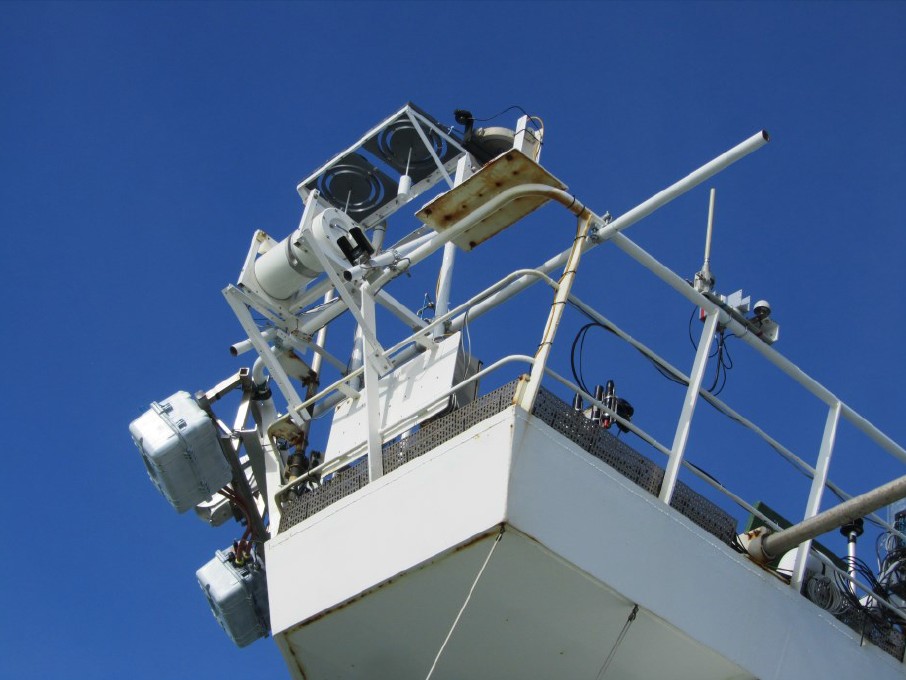
Werenfrid’s infrared radiometer and the IFREMER c-band radar system
The events over the course of the day are orchestrated by the Principal Scientific Officer (PSO), Andy Rees (PML, UK) who, in collaboration with the officers on the bridge and crew on the deck, ensures that each operation runs smoothly to maximise the collection and accuracy of measurements and data. Underpinning all of the day’s scientific operations are the Captain, Jo Cox, and Officers (Phil, Declan and Nick) who ensure safe navigation between and on stations; The Engineers (C/E Andy, 2nd/E Del, 3rd/E’s Martin & Angus, ETO Tom, ERPO Niel) who keep the engines, water supply and treatment and electricity supply running; The Crew (Steve, Nathan, Andy, Chris, Gary, Simon) who ensure safe deployment of all of our gear and instruments and last but not least the Galley staff (Purser – Graham, Head Chef – Peter, Chef – Steve) and Stewards (Tina & Carl), who provide 3 sumptuous meals daily (from vegetarian, to vegan, and Asian-Indian to gluten free) to give us the energy to sustain the day’s activities.
Measurements are made around the clock, 24/7, in mill-pond calm seas to howling ocean gales as the ship is tossed around like a roller coaster ride, 7 days a week for 7 weeks. Relaxing on deck in the tropical sun is what an ocean-going scientist dreams of at night from their bunk!
Post from Gavin Tilstone (PML)








Discussion: no comments